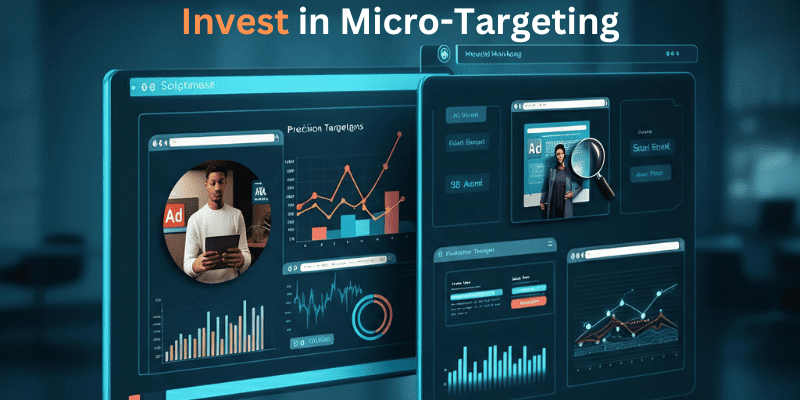Why You Should Invest in Micro-Targeting for Ads?
Published: 07/Mar/2025
Digital advertising has come a long way. No longer do businesses need to rely on generic billboards or expensive TV spots that may reach only a fraction of their intended audience. Instead, with advancements in technology, companies can now speak directly to their ideal customers. The key to this precision? Micro-targeting.

Micro-targeting is transforming the advertising world, providing businesses with the tools to make their campaigns more effective and cost-efficient. But what exactly is micro-targeting, and why should marketers and businesses prioritize it? That’s exactly what we’ll explore. From its benefits to actionable strategies, tools, case studies, and even predictions for the future, this blog will show you why you should invest in micro-targeting today.
What is Micro-Targeting and Why Does It Matter Now?
Micro-targeting is the practice of delivering highly specific ads to audience segments based on data points like demographics, behaviors, interests, and more. Rather than casting a wide net, it focuses on hitting the bullseye, showing ads to the people who are most likely to take action.
This approach matters more than ever because competition in digital advertising is fiercer than it’s ever been. Whether you’re marketing shoes, software, or services, it’s not enough to just “reach everyone.” Investing in Micro-Targeting ensures your media spend gets optimized and works to drive actual results, like higher engagement, conversions, and ultimately, ROI.
Benefits of Micro-Targeting
Why is micro-targeting worth the hype? Here are some reasons why targeted advertising is good for your business.
1. Maximized ROI
Micro-targeting ensures that every advertising dollar is spent on someone likely to convert. By targeting only those who are genuinely interested in your product or service, you reduce wasted spending and achieve a greater return on investment.
2. Personalized Customer Experiences
Consumers expect personalized experiences now more than ever. Micro-targeting lets you deliver the right message to the right person at the right time. For example, an outdoor enthusiast may see ads for hiking gear in their social feeds, while city dwellers are shown trendy, compact travel equipment.
3. Smarter Campaign Insights
By analyzing small audience segments, micro-targeting enables marketers to gather better insights about audience preferences, behaviors, and habits. This data creates a feedback loop, continuously improving campaigns over time.
4. Improved Brand Connection
When consumers see ads that resonate with their interests or align with their values, they’re more likely to engage and trust your brand. A stronger connection means more loyalty and repeat business.
Micro-Targeting Strategies
Micro-targeting is nothing without a strategy. Here are three core methods to get started.
1. Demographic Targeting
- Focus on age, gender, location, income level, or education.
- Example: A local bakery can micro-target young professionals in their city with promotions for a weekday breakfast special.
2. Behavioral Targeting
- Target based on browsing habits, purchase history, and online activity.
- Example: Retargeting ads that show items abandoned in an online shopper’s cart.
3. Psychographic Targeting
- Focus on values, lifestyle, and hobbies.
- Example: A sustainable clothing brand could target eco-conscious consumers with messaging highlighting their commitment to reducing waste.
Tools and Platforms for Micro-Targeting
You don’t need to be a tech wizard to get started with micro-targeting. Many platforms make it easy. Here are the best tools to help you invest in micro-targeting for ads.
1. Social Media Ads
Platforms like Facebook, Instagram, and LinkedIn offer robust targeting options, allowing you to narrow your audience by location, interests, behaviors, and more. Why are targeted ads good on these platforms? Invest in Micro-Targeting because it ensures your creative is shown only to relevant users.
2. Google Ads
Leverage Google Ads to target users based on search intent, industry, and location with Pay-Per-Click (PPC) strategies. It’s a go-to for driving leads and boosting conversions quickly.
3. Programmatic Advertising Platforms
Tools like The Trade Desk allow brands to serve highly specific ads across various websites, apps, and streaming services.
4. CRM and Email Marketing Tools
Platforms like HubSpot or Mailchimp can segment your customer emails so campaigns feel bespoke. Advanced tools use AI to predict when customers are most likely to engage.
Case Studies: Micro-Targeting Success Stories
Successful businesses are proof of why targeted advertising is good. Here are two powerful examples.
1. Airbnb’s Tailored Ads
Airbnb uses micro-targeting to show users travel ads that are hyper-localized to their dream destinations. By tracking user preferences (search history, saved filters), they tailor both the imagery and offers. This approach leads to a high click-through rate and, ultimately, more bookings.
2. Nike and Lifestyle Marketing
Nike’s campaign targeted customers based on activities they most enjoy, such as running or yoga. Ads were paired with motivational content that made customers feel understood by the brand, leading to a spike in product sales and social engagement.
3. Netflix’s Personalized Recommendations
Netflix is a leader in micro-targeting, recommending shows and movies based on a user’s viewing history. This personalized experience has resulted in a huge increase in user satisfaction and retention.
4. Nike’s Custom Content Campaign
Nike used micro-targeting to create location-specific ads highlighting local athletes and events. This strategy increased their engagement rates by over 90%.
5. A Small Café Uses Geo-Targeting
A local coffee shop ran micro-targeted Instagram ads to reach people within walking distance, offering a 20% discount. The result? A 40% uptick in foot traffic during the campaign’s deployment.
6. Coca-Cola’s Psychographic Focus
Coca-Cola’s “Share a Coke” campaign leveraged names and encouraged personalization, resulting in millions of social interactions worldwide.
These success stories highlight why targeted advertising is good for both large enterprises and smaller businesses alike.
The Future of Micro-Targeting
The world of micro-targeting is only getting smarter. With tools such as machine learning and AI, marketers can expect to anticipate what customers want before they even know it themselves. Platforms are also becoming more transparent, emphasizing privacy while still delivering relevant ads.
Additionally, trends suggest that contextually targeted ads (ads shown based on the content users are currently engaging with) will make a resurgence, reshaping digital advertising norms.
For businesses, understanding these trends and adopting them early can create a strong competitive edge.
Frequently Asked Questions (FAQs)
1. How is micro-targeting different from traditional advertising?
Traditional advertising aims for broad reach, often talking to everyone. Micro-targeting, on the other hand, focuses on small, specific groups to make ads more relevant and effective.
2. Can small businesses afford micro-targeting?
Yes! Platforms like Facebook and Google Ads allow budget flexibility, making micro-targeting accessible even for small businesses on tight budgets.
3. Does micro-targeting invade privacy?
Reputable platforms comply with privacy regulations like GDPR and CCPA. It’s important for advertisers to always use data responsibly and transparently.
4. What industries benefit most from micro-targeting?
Virtually any industry from retail and travel to tech and healthcare, can benefit if they deliver tailored messages to their audience.
5. What’s the first step to getting started with micro-targeting?
Start small. Use existing tools like Facebook Ads Manager or Google Ads and experiment by creating defined audience segments based on your customer data.
Take Your Advertising to the Next Level
Investing in Micro-Targeting isn’t just a new way of advertising; it’s the modern way. If your goal is to minimize wasted ad spend while maximizing ROI, there’s no better method to adopt.
Want proven tools to start your micro-targeting strategy? Sign up for Google Ads, explore Facebook Ads Manager, or research why targeted ads are good for making every dollar count.
Start leveraging this game-changing strategy today, and see the difference in your campaigns tomorrow.
You may also like these posts!
1- Why focus on retargeting ads to increase sales?
2- How to build a strong online reputation with digital PR?
3- Why your business podcast marketing?





